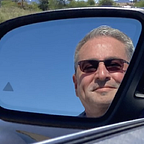Detour: Chasing Eccentricity
How I find my stories
People frequently ask how I uncover the odd crime stories I write about.
First, I choose a location to which I’d like to travel. So far, I’ve been focusing on the Desert Southwest because it’s close and accessible. I select places I find interesting, whether or not I’ve been there before: big cities like Phoenix, Las Vegas, and Los Angeles and smaller towns like El Centro, Sedona, and Blythe.
I maintain a list of about 35 crimes I find intriguing, including theft, fraud, sex, injustice, confidence games, and escapes. Within each bucket are various specific situations. I’m currently looking for smuggling, academic research fraud, pyramid schemes, counterfeiting, and homicides triggered by inheritance disputes. I try not to feature too many murders and avoid anything too gruesome or repulsive.
Then, I review local history websites and historical newspapers from several archives for every crime I can find between 1920 and 2000. I prefer stories from the fifties to the seventies because I like writing about midcentury architecture and travel.
Usually, I find hundreds of possibilities. I filter them to match my interests: oddball characters, unexpected twists, and windows into human nature. I eliminate unresolved crimes because I find such stories unfulfilling as a reader. I try to avoid tales that fit clichés or tropes. Another filter is whether the crime is sufficiently documented. Sadly, I have to jettison some fascinating cases because they weren’t adequately covered in newspapers, and there are no books or articles about them. Sometimes, the cases are well-reported, but there is so little insight into the people involved that the characters can’t come to life.
Then comes the storytelling. Facts don’t arrive in a narrative. I have to piece them together to make them intriguing and readable. Often, I throw out stories at this stage, though I sometimes find that adopting a different participant’s point of view or sequencing the story in a particular way makes it work.
When planning the trip to Bakersfield that I’m currently on, I was searching newspapers.com for a crime involving a lottery winner when I came across the story about the murder of a Lotto winner in San Marcos. It only popped up because Bakersfield was mentioned in another story on the same page. For last week’s piece on the POW escape, I was searching for major historical crimes in Phoenix when Google led me to a Reddit page that briefly mentioned the escape and linked to Wikipedia. I don’t find Wikipedia a reliable source, but sometimes the references at the bottom link to good resources, in this case two books on the POW camp.
I currently have five stories in some stage of production and six more identified. I still need to travel for almost all of them. More Arizona and New Mexico stories are coming, but I’ll also be spending time around Los Angeles (an endless reservoir of eccentricity), and I’m planning a Colorado trip. So the geography of the stories will expand.
This week, I’m on a road trip to California’s Central Valley investigating a fascinating bank robber, a motel murder, and a home invasion that mimics In Cold Blood. Stay tuned.
Copyright © 2024 Lou Schachter • All rights reserved
